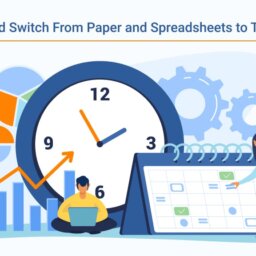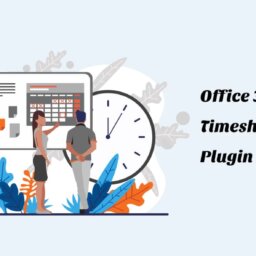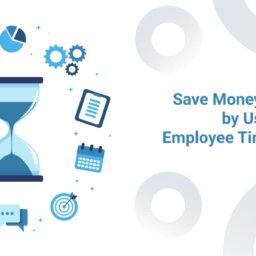Introduction
So, you finally decided to implement time tracking. You convinced the leadership team that it’s essential to running projects successfully. You got a budget from the CFO. You researched and tested different tools before finding the right fit for your organization. You did all this work, and the day it all pays off arrives. You finally introduce this brand new time tracking solution to your team. And, the response? Crickets.
No one’s tracking time. What’s worse, you’re now wasting time you don’t have cajoling people to submit their timesheets. You know time tracking is essential to your business, but now you’re ready to give it up entirely just to get rid of this massive headache.
Before hop into the office 365 timesheet benefits, features, and usage. Gather information about office 365 timesheet Ignatiuz software.
Office 365 timesheet is the software to keep a track record of how much time an employee spends on tasks or client projects. Before the timesheet software era, businesses are dependent on different methods such as paper, spreadsheets, and online time-tracking software to gauge their employees’ contribution daily. Now with the advancements in technology, organizations have replaced ancient-timesheets methods with office 365-timesheet apps because of their ease to use and maintenance.
A timesheet app has the data table businesses use to track the time spent by employees on a project or task. Timesheets are an inseparable part of the business’s day-to-day operations. While employees must feel their timesheets, employers or middle-level managers have to approve them on-time. To prevent any error in the timesheet app or software businesses should learn the entire concept of the timesheet app. When done manually, the time tracking might pose challenges, and there is a high scope for human errors or inaccuracies. Here comes the role of robust timesheet software.
Helps the optimum utilization of resources
- Microsoft team’s time tracking app gives businesses opportunities to track individual contributions on a project-level or business-level operations
Bill accurately
- Timesheets are another way to bill projects accurately. With a real-time tracking system, businesses show the status of their projects. It helps build trustworthy relationships between the businesses and the clients where they can monitor their money being utilized efficiently. The timesheet app lets them see how much time you dedicate to their projects and serve as proof of how precise your billing is.
Easy for billing
- Employee timesheet software is also helpful for billable hours services. Through this app, businesses get a chance to reduce time on billing and money while staircase the revenue upward.
Improve project management
Timesheets are beneficial for businesses in project management in the following ways.
- Identify the area where your employees need additional training to give 100% performance on a project.
- Helps measure the overall efficiency of the project.
- Help track down the availability of employees.
- The employee tracking software helps you to gather information and resources to meet the deadline of a project.
- Assist project managers with the cost estimation process and compare them to the real cost of the project during execution.
It’s a story we hear all the time. But never fear! There are steps you can take to guarantee that time tracking is successfully rolled out to your organization.
- Communicate the value of time tracking – Sometimes all it takes is being upfront with your team about why the business needs to track time. Just understanding the ‘why’ can go a long way toward motivating them to get tracking.
- Onboard your team – Make sure your expectations are clear and there’s a system in place to make the launch of time tracking as seamless as possible. Let your team know about all the different options they have when it comes to tracking time.
- Integrate time tracking into your workflow – Your team is more likely to track time if it’s incorporated into their existing workflow. Utilize apps and integrations to make tracking time as frictionless as possible.
- Make time tracking a positive experience – Motivate your team by making time tracking something they actually like. Use the data to improve their lives and reward them for good time tracking habits.
Follow these tips and your team will be tracking time like a well-oiled machine.
Communicate the value of time tracking
Most people get frustrated when they feel like they’re being made to do something for no reason. If they’re going to spend time on something, they want to know why. This means the first and most important step in getting your team on board is: Be upfront about the reasons they need to track time and what you’re going to do with the data.
Be transparent about why time tracking is important
Most people genuinely want their companies to succeed. They’re willing to go the extra mile to make sure that happens. Be clear about how time tracking is key to that success. You can even go an extra step and share examples of the actual reports you’re going to create with their timesheet data.
Here are a couple of common reasons companies track time, which you can bring up with your team:
- Tracking billable time – If you bill by the hour, show your team how their tracked time will be pulled into invoices, and how the company’s revenue is contingent upon them tracking time.
- Keeping projects on track – If you’re using time tracking to make sure projects stay under budget, show people the actual reports you’re going to create to track project progress.
- Making better estimates – Show people how time tracking will allow you to create a library of past projects, and how that info will improve your estimates and pricing.
Be upfront about what time tracking is not for
There’s a lot of fear surrounding time tracking. Many people think it means Big Brother will be watching everything they do. Reassure people (and encourage them to track time) by being clear about what’s not going to happen.
Let your team know that you won’t be using time tracking to spy on, micromanage, or judge them. Yes, there are some icky tools out there that monitor what people are doing or take screenshots of their computers. Be clear that’s not what this is about.
Also, emphasize that accuracy is the most important thing and that there’s no magic number of hours you’re looking for them to hit each week. Let them know you’re not going to punish them if they work less than forty hours in a given week. Otherwise, your team might just make up what they think you want to see.
Onboard your team
How you introduce time tracking to your team can have a big impact on whether they end up tracking time. Here are some tips for smoothly and successfully introducing time tracking:
Give a presentation
No one likes adding an extra meeting to the week, but in this case an all-hands meeting to introduce the new tool helps. It makes sure everyone is on the same page. It also gives you an opportunity to address their questions and concerns.
Here are some things to cover:
- Explain why you’re tracking time – Go over all the reasons it’s necessary to track time. This is a great time to show off some sample reports or invoices, and explain why time tracking is essential to getting this information.
- Let people know about their options – Depending on what tool you’re using, there are likely many different ways for people to enter time—running live timers or entering time after the fact, using android or ios apps, tracking from integrations or browser extensions. Make sure to educate your team and help them find a way to track time that works for them. If people can track time in a way that suits them best, they are more likely to do it.
- Demo a timer – Most people are familiar with logging time in a spreadsheet, but starting a time tracking tool as you work might be a new concept. Many people assume it will be a pain but once they try it, they find it’s much easier (and faster) than they thought. A little demo for your team can help them see that right away. Book a demo here.
Set a schedule
A consistent schedule helps keep everyone on the same page and eliminates any stress around expectations. Choose one day when everyone’s timesheets are due. Most organizations pick something like Friday afternoon or Monday morning. This way people know when they have to have timesheets completed by, and they know when they’re likely to receive a follow-up.
Don’t forget to remind them when it’s that time of the week. An automatic Slack reminder or recurring calendar event can do the trick. Your time tracking tool might have a reminder function built right into it that you can take advantage of too.
Create a legend
When you track time, your team has to record what client, project, and task they’re working on, otherwise the information’s usefulness is limited. For some people, it might not be clear what exactly they should be tracking their time to. When is something design vs. development? If they’re researching info for a blog post, should that be tracked as research or writing?
Create a legend that includes a quick description of each project and task. Make it clear what people should track their time to in common situations like meetings or emails. Also, make sure there’s a process for adding new projects and tasks in your time tracking tool.
Make someone accountable
The reality is that time tracking is likely to fall through the cracks every now and then, even on the best teams. If there isn’t someone there to provide a gentle reminder, you might find that it just doesn’t get done.
Make someone accountable for time tracking across the whole company, and consider building it into their job description to help make sure it actually happens. This gives the team someone to give feedback to if they think the system could be improved—sometimes the best way to get your team to track time is to engage them in the process.
Don’t forget about new hires
Even if you give your team a great presentation and answer all their questions, that’s not going to help everyone who’s hired after the presentation. Make sure new hires get the same information communicated to them as part of the onboarding process. It might even be worth sitting down with each one for ten minutes to go over your time tracking tool and what’s expected of them. When time tracking is clearly communicated as one of the expectations of their new role, they’re more likely to do it.
Integrate Office 365 Timesheet app into your workflow
Every time you ask people to interrupt what they’re doing or switch contexts in order to start a timer, you’re creating friction that makes time tracking less likely to happen. Integrating time tracking into your team’s workflow eliminates this friction and makes it easier for people to track their work.
Plus, integrating office 365 timesheet app into your workflow makes time tracking that much more visible. If your team sees a timer where they normally work, that can prompt them to track time when they otherwise might have forgotten.
Please visit here to know more about Office 365 Timesheet app. https://www.ignatiuz.com/products/office-365-timesheet-app/
Would you like to discuss to know more about the app? Book a meeting here
Make time tracking a positive experience
Motivating your team is hard work. It can be tempting to lay down the law and impose negative consequences for not tracking time. But it can be a lot more effective if you make time tracking a positive experience for your team, and emphasize all the good that can come from tracking time. This way, they’ll genuinely look forward to doing it, instead of just seeing it as a necessary evil.
Here are some ways to ensure time tracking has a positive impact on your team:
Prevent burnout
Use data collected through time tracking to prevent burnout and reinforce a good work-life balance. If you notice people consistently going over forty hours a week, you can actively intervene and get some work off their plate. When people know you’re using their time to have their back, they’ll be way more likely to track time.
Improve how projects are run
Sometimes people don’t realize how much time they really spend on meetings, emails, or other internal processes until they see those hours tallied up. Use that data to cut down on wasteful internal work. Your team will appreciate it.
Help people help themselves
Time tracking gives interesting insight into how you work. Do you spend more time checking email than working on actual deliverables? Does most of your time go toward your biggest priorities, or are you constantly distracted by smaller tasks? Time tracking data can empower people to improve their work habits. Let the members of your team in on this data to motivate them to track more accurately.
Reward people for tracking time
A little bribery never hurt! Think about ways you can reward your team when they do an especially good job of tracking time. Maybe you can buy them lunch every week that 100 percent of timesheets are in on time. We’ve even heard of agencies that only give employees access to the beer on tap in the office if they’ve submitted their timesheets. Maybe a month of successfully submitted timesheets could lead to happy hour at a local bar or a company outing. Get creative and make time tracking something your team actually looks forward to!
Don’t make time tracking a negative experience
Whatever you do, be careful about associating time tracking with punishment. If time tracking creates a negative experience for your team, they’ll come to resent it, and every week will turn into a battle. Avoid publicly shaming people on Slack or a company-wide email. You also want to avoid monetary punishments for forgetting to submit timesheets, like refusing to pay people or withholding their bonuses. As hard as it is sometimes, it’s better to use positive motivation to get timesheets in.
Conclusion
We hope these tips put your team on the path to time tracking success! The most important thing is to find a system that works for your team. It can take a little experimentation, and you might run into some resistance, but don’t lose heart! Once people get into the groove of tracking time, you’ll be surprised by how painless it is.
And of course, a lot of that comes down to having the right tool. If you’d like to check out how Office 365 Timesheet App can help your team get up to speed with time tracking, you can learn more about the app here, or even jump into a free 14 days trial and take it for a test drive yourself.




















